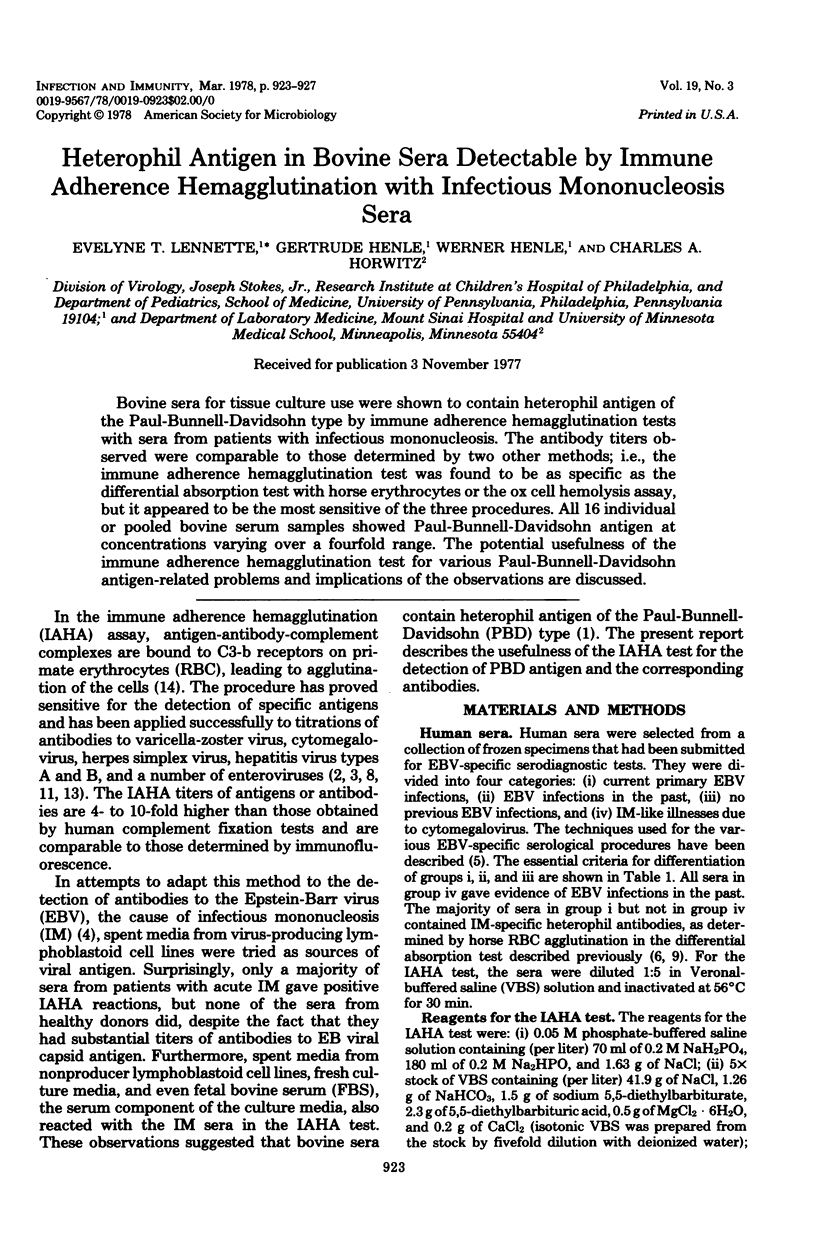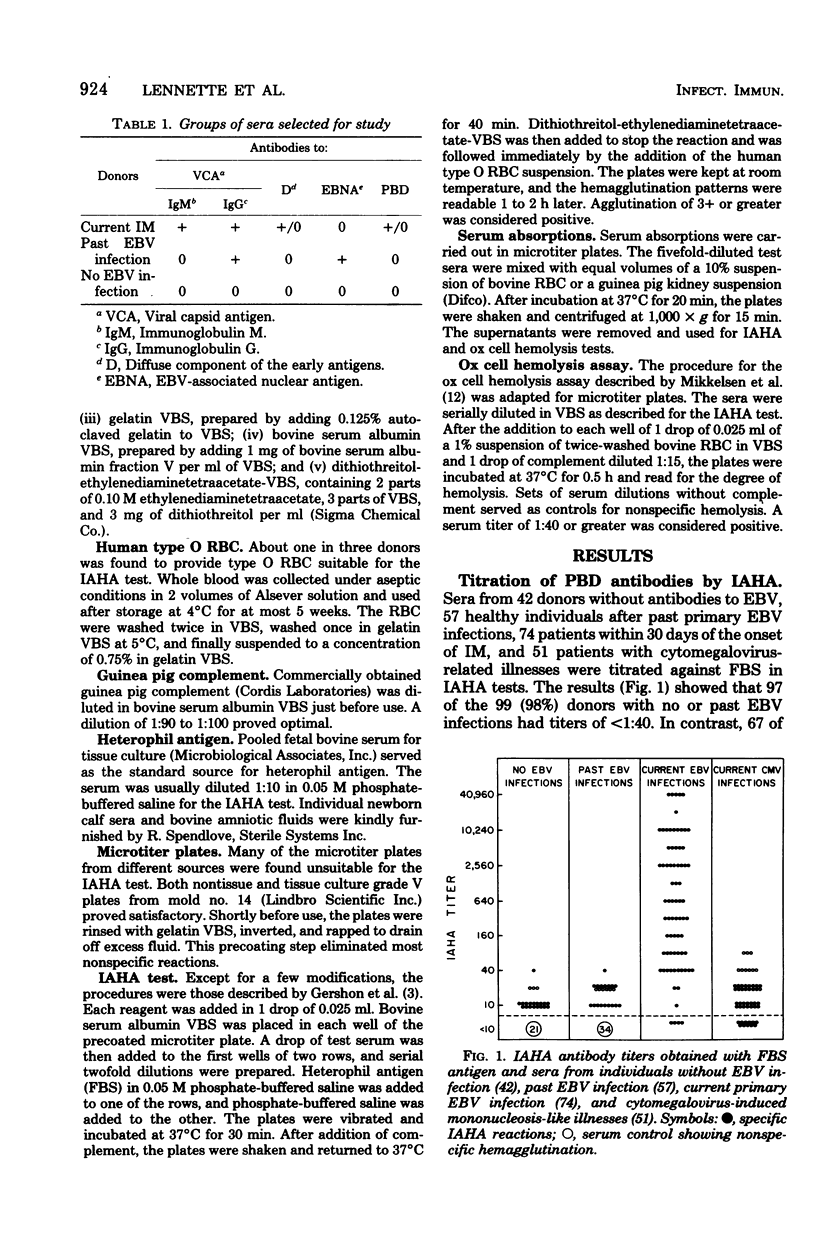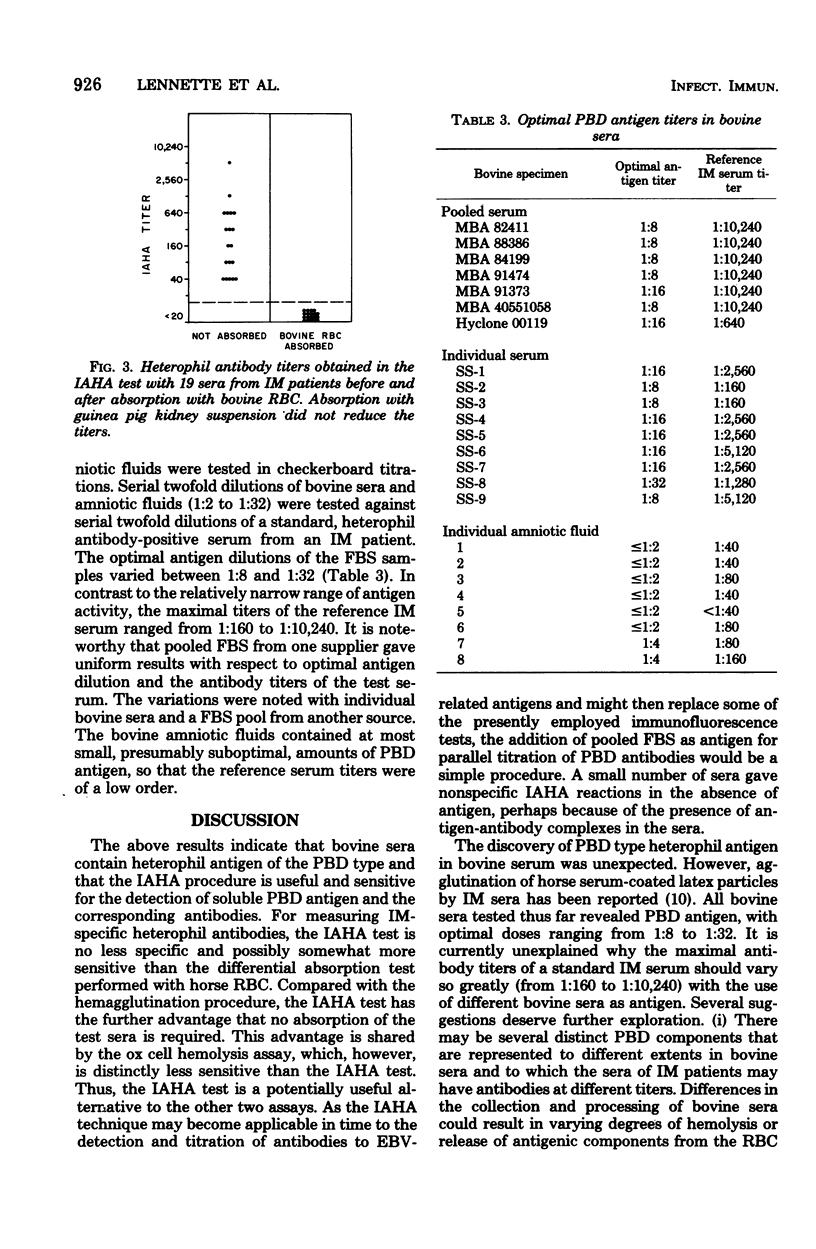Abstract
Bovine sera for tissue culture use were shown to contain heterophil antigen of the Paul-Bunnell-Davidsohn type by immune adherence hemagglutination tests with sera from patients with infectious mononucleosis. The antibody titers observed were comparable to those determined by two other methods; i.e., the immune adherence hemagglutination test was found to be as specific as the differential absorption test with horse erythrocytes or the ox cell hemolysis assay,but it appeared to be the most sensitive of the three procedures. All 16 individual or pooled bovine serum samples showed Paul-Bunnell-Davidsohn antigen at concentrations varying over a fourfold range. The potential usefulness of the immune adherence hemagglutination test for various Paul-Bunnell-Davidsohn antigen-related problems and implications of the observations are discussed.
Full text
PDF




Selected References
These references are in PubMed. This may not be the complete list of references from this article.
- Dienstag J. L., Cline W. L., Purcell R. H. Detection of cytomegalovirus antibody by immune adherence hemagglutination. Proc Soc Exp Biol Med. 1976 Dec;153(3):543–548. doi: 10.3181/00379727-153-39588. [DOI] [PubMed] [Google Scholar]
- Gershon A. A., Kalter Z. G., Steinberg S., Kuhns W. J. Detection of antibody to Varicella-Zoster virus by immune adherence hemagglutination. Proc Soc Exp Biol Med. 1976 Apr;151(4):762–765. doi: 10.3181/00379727-151-39302. [DOI] [PubMed] [Google Scholar]
- Henle W., Henle G. E., Horwitz C. A. Epstein-Barr virus specific diagnostic tests in infectious mononucleosis. Hum Pathol. 1974 Sep;5(5):551–565. doi: 10.1016/s0046-8177(74)80006-7. [DOI] [PubMed] [Google Scholar]
- Horwitz C. A., Henle W., Henle G., Polesky H., Wexler H., Ward P. The specificity of heterophil antibodies in patients and healthy donors with no or minimal signs of infectious mononucleosis. Blood. 1976 Jan;47(1):91–98. [PubMed] [Google Scholar]
- Irie R. F., Irie K., Morton D. L. Natural antibody in human serum to a neoantigen in human cultured cells grown in fetal bovine serum. J Natl Cancer Inst. 1974 Apr;52(4):1051–1058. doi: 10.1093/jnci/52.4.1051. [DOI] [PubMed] [Google Scholar]
- Ito M., Tagaya I. Immune adherence hemagglutination test as a new sensitive method for titration of animal virus antigens and antibodies. Jpn J Med Sci Biol. 1966 Jun;19(3):109–126. doi: 10.7883/yoken1952.19.109. [DOI] [PubMed] [Google Scholar]
- Lee C. L., Zandrew F., Davidsohn I. Horse agglutinins in infectious mononueleosis. 3. riterion for differential diagnosis. J Clin Pathol. 1968 Sep;21(5):631–634. doi: 10.1136/jcp.21.5.631. [DOI] [PMC free article] [PubMed] [Google Scholar]
- MADONIA J. P. THE LATEX-PROTEIN AGGLUTINATION TEST AS A SCREENING DIAGNOSTIC PROCEDURE IN INFECTIOUS MONONUCLEOSIS. Am J Med Technol. 1964 Jul-Aug;30:223–228. [PubMed] [Google Scholar]
- MIKKELSEN W., TUPPER C. J., MURRAY J. The ox cell hemolysin test as a diagnostic procedure in infectious mononucleosis. J Lab Clin Med. 1958 Oct;52(4):648–652. [PubMed] [Google Scholar]
- Mayumi M., Okochi K., Nishioka K. Detection of Australia antigen by means of immune adherence haemagglutination test. Vox Sang. 1971 Feb;20(2):178–181. doi: 10.1111/j.1423-0410.1971.tb00549.x. [DOI] [PubMed] [Google Scholar]
- Miller W. J., Provost P. J., McAleer W. J., Ittensohn O. L., Villarejos V. M., Hilleman M. R. Specific immune adherence assay for human hepatitis A antibody application to diagnostic and epidemiologic investigations. Proc Soc Exp Biol Med. 1975 May;149(1):254–261. doi: 10.3181/00379727-149-38783. [DOI] [PubMed] [Google Scholar]
- Sulit H. L., Golub S. H., Irie R. F., Gupta R. K., Grooms G. A., Morton D. L. Human tumor cells grown in fetal calf serum and human serum: influences on the tests for lymphocyte cytotoxicity, serum blocking and serum arming effects. Int J Cancer. 1976 Apr 15;17(4):461–468. doi: 10.1002/ijc.2910170408. [DOI] [PubMed] [Google Scholar]


